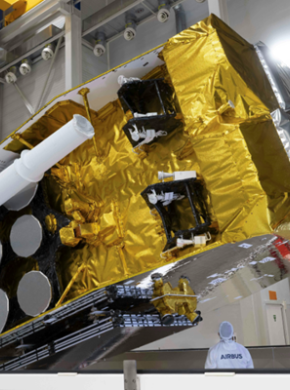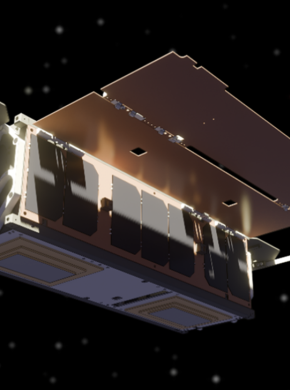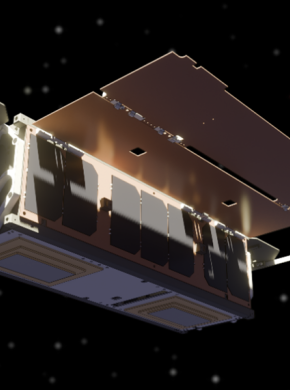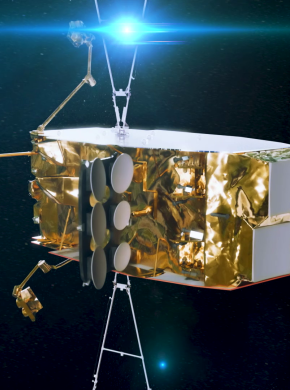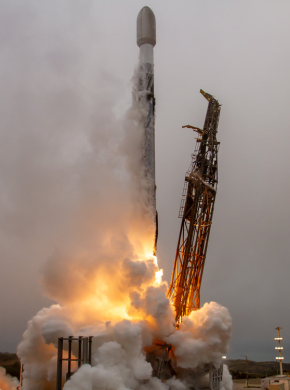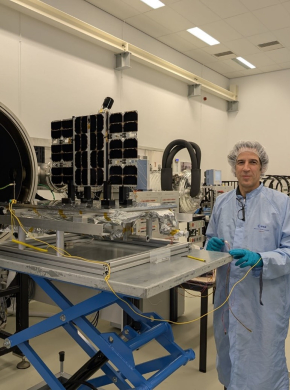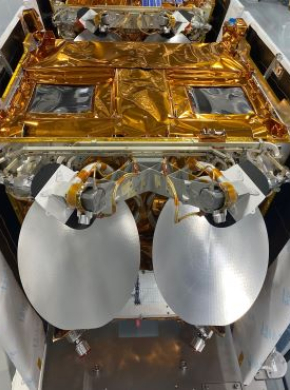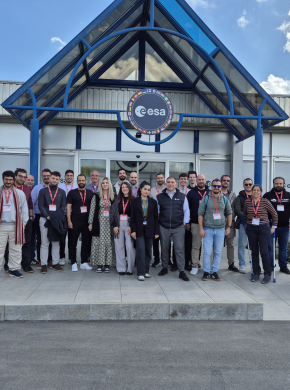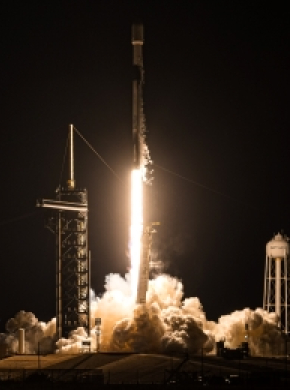Pacis 3 is a Partnership Project (PP) involving satellite operator Hisdesat and the European Space Agency (ESA), with support from Spain’s Centre for the Development of Industrial Technology (CDTI).
ESA Telecom’s PPs develops new sustainable end-to-end systems, up to in-orbit validation.
The Pacis 3 project objectives are the development and integration of the reconfigurable transmit and receive X-band active antennas for secure communications, and the deployable pallet with six individually steerable Ka-band antennas.
These antennas are developed under the leadership of Airbus Defence and Space, Spain, as industrial prime, together with a group of Spanish space industries (SENER, INDRA, IBERESPACIO, Airbus CRISA, TECNOBIT, GMV).
“The X-band active antennas are the most challenging active antennas that have ever been developed in Europe, positioning Hisdesat and the Spanish space industry at the edge of the space technology in active antennas meaning higher competitiveness in the global market,” said Miguel Ángel García Primo, Hisdesat’s CEO.
Pacis 3 is part of Hisdesat’s much larger overall SpainSat NG programme that comprises two new generation satellites based on Airbus’ new Eurostar Neo product line. Both satellites are to be launched in 2024 and 2025 respectively, to be used for secure communications.
The Pacis 3 project will also demonstrate in-orbit innovative pooling and sharing services, in support of ESA’s Govsatcom Precursor activities.
Flight Hardware integration Underway
The Pacis-3 Critical Design Review (CDR) was achieved in 2021, two years after contract signature. Both the Ka-Band and X-Band qualification and validation activities are now nearing completion:
- Ka-Band: The Mechanical Reflector Assembly (MRA), composed of a reflector and the pointing mechanism, has recently completed its qualification campaign. The pallet assembly and feed-chain clusters will subsequently be delta qualified at satellite and Ka-Band payload level.
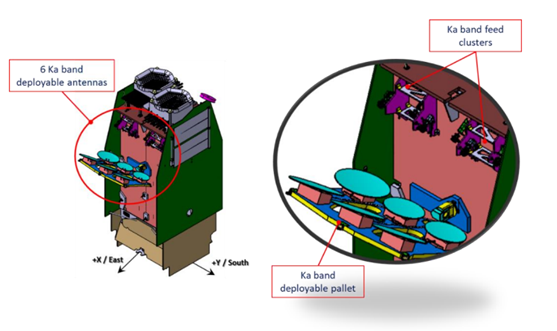
- X-Band: For the innovative reconfigurable and geo-locating “Direct Radiating Antenna” (DRA), validation and risk reduction testing on flight representative hardware has been performed. This has been based principally on the Design Validation Model (DVM) and Thermal Model (TM).

In parallel, Flight hardware manufacture and integration in ADS Madrid is now underway for all sub-systems of the Ka-Band and X-Band payloads:
- Ka-Band: PFM pallet assembly with 6 steerable MRAs and feed cluster assemblies are presently in the manufacturing phase with delivery for satellite integration and testing beginning in 2023.
- X-Band: All flight elements are being delivered on a batch basis by the industry sub-contractors allowing the incremental assembly of the transmit and receive X-Band PFM DRAs. Transmit and receive X-band DRAs delivery for satellite integration and testing is planned by mid-2023.
Further information
The following innovative technologies are worthy of special attention in regards to Pacis 3:
- Ka-Band: The Sener reflector pointing mechanism achieves high precision orientation of each antenna, combining the rotational motion of two actuators in a spherical mechanism of minimum size. The This innovative mechanism removes the need for any Hold-down and Release Mechanism (HRM).
- X-Band: The Sener Dual Solid State Power Amplifier (DSSPA) is built around a High-Power Amplifier IC designed and produced by UMS using their GH25, 0.25 µm Gallium Nitride (GaN) process. This technology is state of the art and able to deliver high RF power level. High reliability and world-class performance have been demonstrated at high temperature.
- X-Band: The Indra Multichip Control Modules (MCCM) are at the heart of the X-Band beam control and are based on high performance, miniaturized hybrid circuitry.
- X-Band: The Iberespacio Collecting Heat Pipe Assemblies (CHPAs) and Loop Heat Pipes (LHPs) meet the challenge of thermally controlling the DSSPAs of the high dissipative Active Antenna. A system of 6 Collecting Heat Pipe Assembles (CHPAs) connected in parallel to 8 operating Loop Heat Pipes (LHPs) achieves efficient heat transfer to the spacecraft wall panels.
FEATURED OPPORTUNITIES
ARTES 4.0 Pioneer Call for Proposals Opened
View details
NEWS AND EVENTS
ESA-supported SpainSat NG II success builds towards next-gen secure satellite communications
The European Space Agency’s (ESA) Pacis 3 Partnership Programme, a precursor to the European Union’s GOVSATCOM, showcases Europe’s innovative industrial capabilities through the successful deployment of the second satellite in the SpainSat NG…
PHASMA and MICE-1 missions supported by ESA launched to expand Greece’s foothold in low Earth orb…
The Greek missions are part of a wave of CubeSats developed in collaboration between the European Space Agency, the European Union and the Greek government to advance the country’s technological independence in the space sector with Secure…
Three further ESA-supported Greek CubeSats ready for launch
The next batch of the Greek In-Orbit Demonstration (IOD)/ In-Orbit Validation (IOV) CubeSat missions – developed with support from the European Space Agency (ESA) – is ready for launch in November this year. Having successfully completed…
Quantum-enabled communications coming to Europe: ESA signs contract with Honeywell for delivery of…
The next step towards quantum-enabled sovereign and secure connectivity for Europe was made this week, as Honeywell signed a contract with the European Space Agency initiating the delivery phase of the Quantum Key Distribution Satellite (QKDSat)…
SpainSat NG I telecommunications payload successfully activates in orbit, showcasing Pacis 3 i…
A payload featuring advanced telecommunications antennas, developed under the European Space Agency (ESA)-Hisdesat Pacis 3 Partnership Project and carried on board the SpainSat New Generation I (NG I) satellite, has…
Operations, commissioning and calibration activities…
DUTHSat-2, the first of the Greek In Orbit Demonstration (IOD) CubeSat missions, has successfully launched from the Vandenberg Air Force Base in California, US, on 23 June on a SpaceX Falcon 9. The 6U CubeSat was one of many payloads aboard the…
ESA-supported Hellenic Assembly, Integration & Testing Facility Clean Roo…
The European Space Agency (ESA), in collaboration with Hellenic Aerospace Industry S.A. (HAI) as prime contractor and BCT Group as main subcontractor, has officially kicked off the contract for the implementation of a cleanroom and supporting…
First ESA-supported Greek In-Orbit Demonstration (IOD) CubeSat ready for launch
The first of the Greek In-Orbit Demonstration (IOD) CubeSat missions, DUTHSat-2, which is led by the Democritus University of Thrace, has been delivered to the launch provider ExoLaunch, and is ready…
ESA, GeoVille and Eutelsat OneWeb to deliver connectivity to distribute Earth observation dat…
A new collaboration between GeoVille and Eutelsat OneWeb, facilitated through the European Space Agency’s (ESA) Sunrise Partnership Project, is set to transform how Earth observation data reaches the world's most remote regions. The "OneWeb…
JoeySat Celebrates its Second Anniversary
The European Space Agency (ESA) and Eutelsat OneWeb teams celebrated a significant milestone in advancing global connectivity solutions as its innovative JoeySat demonstrator satellite marked its second year in orbit.
ESA further supports seven Greek CubeSat missions as part of Operations Workshop
Seven Greek In-Orbit Demonstration (IOD) CubeSat teams came together with experts from the European Space Agency (ESA) in an Operations Workshop at the Agency’s European Space Security and Education Centre (ESEC) in Redu, Belgium. Taking place…
Pacis 3 now in orbit aboard Hisdesat’s SpainSat NG I
The European secure satellite communications sector marked a strategic milestone as SpainSat Next Generation I (SNG I), with ESA’s Pacis 3 antennas onboard, successfully deployed via SpaceX Falcon 9 from Cape Canaveral.



